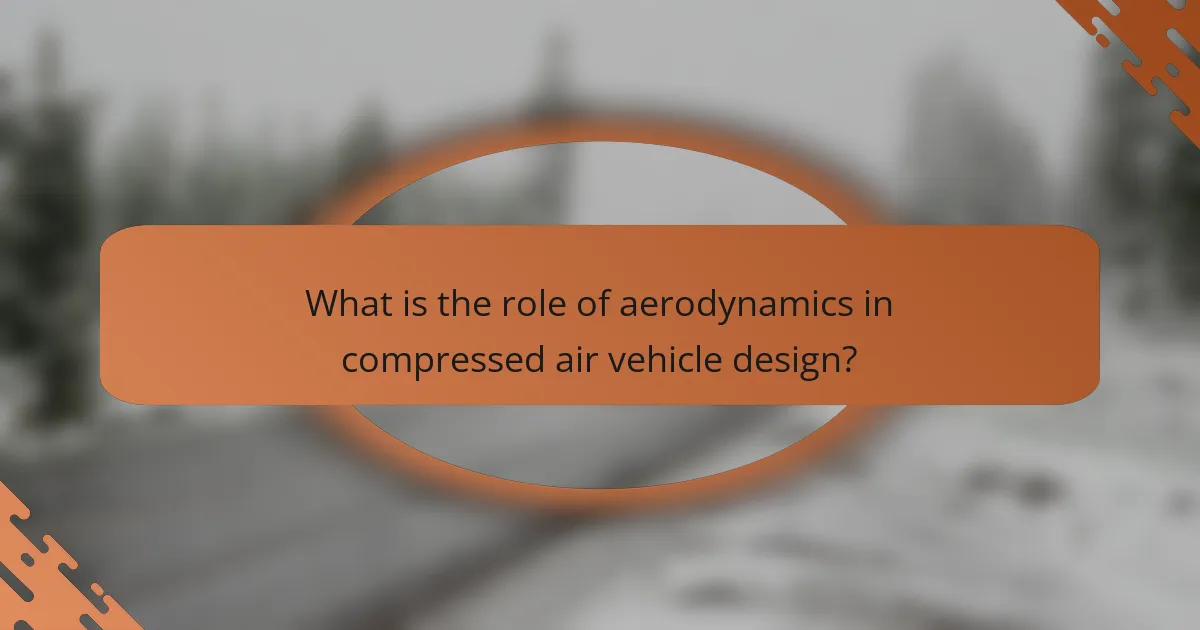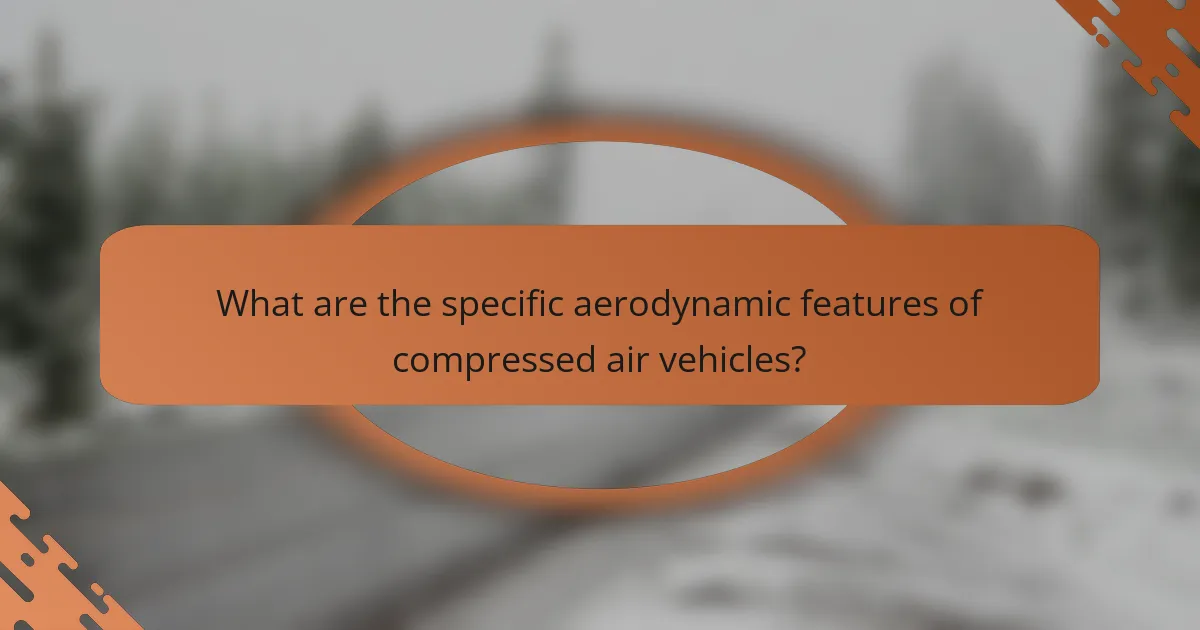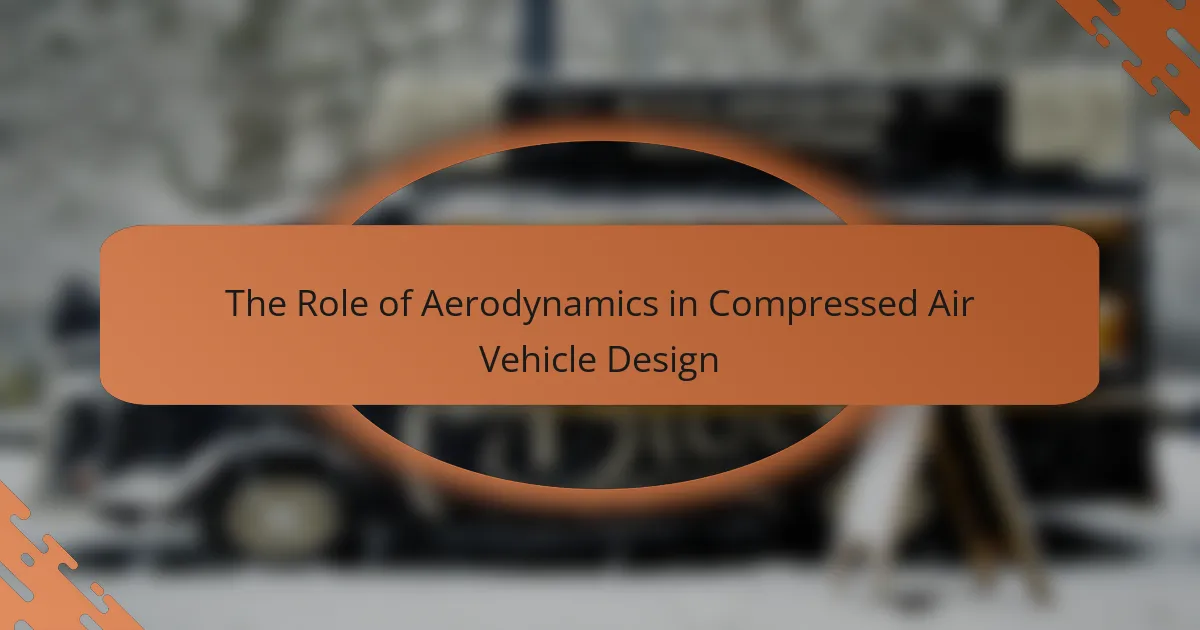Aerodynamics is a critical factor in the design of compressed air vehicles, significantly influencing air flow, drag, stability, and overall performance. Effective aerodynamic design minimizes air resistance, enhancing energy efficiency and extending the vehicle’s range. Key features of these vehicles include streamlined shapes, smooth surfaces, lightweight materials, and active aerodynamic components, all of which contribute to improved handling and control. Research indicates that optimized designs can reduce drag coefficients by up to 30%, underscoring the importance of aerodynamics in maximizing the effectiveness of compressed air vehicles. Techniques such as wind tunnel testing and computational fluid dynamics (CFD) simulations are employed to refine these aerodynamic features for optimal performance and sustainability.

What is the role of aerodynamics in compressed air vehicle design?
Aerodynamics plays a crucial role in the design of compressed air vehicles. It influences how air flows around the vehicle, impacting drag and stability. Efficient aerodynamic design reduces air resistance, allowing for better energy efficiency. This is essential since compressed air vehicles rely on stored energy to propel themselves. Lower drag results in improved speed and range. Additionally, good aerodynamics enhances vehicle handling and control. Studies have shown that optimized shapes can lead to significant performance gains. For instance, streamlined designs can reduce drag coefficients by up to 30%. Thus, aerodynamics is fundamental in maximizing the effectiveness of compressed air vehicles.
How does aerodynamics influence vehicle performance?
Aerodynamics significantly influences vehicle performance by affecting drag and lift. Reduced drag enhances fuel efficiency and speed. For example, streamlined shapes decrease air resistance. This allows vehicles to maintain higher speeds with less energy. Lift impacts stability and handling, particularly at high speeds. Vehicles designed with optimal aerodynamics can achieve better acceleration and braking. Studies show that improving aerodynamic design can increase fuel economy by up to 30%. Overall, effective aerodynamics is crucial for maximizing performance in vehicle design.
What are the key aerodynamic principles relevant to compressed air vehicles?
The key aerodynamic principles relevant to compressed air vehicles include drag reduction, lift generation, and flow management. Drag reduction minimizes resistance against the vehicle’s motion. This principle is crucial for optimizing speed and efficiency. Lift generation allows the vehicle to maintain stability during operation. Proper design can enhance lift while minimizing drag. Flow management involves controlling the airflow around the vehicle’s structure. This ensures smooth movement and reduces turbulence. These principles are essential for maximizing the performance of compressed air vehicles, as supported by aerodynamic studies in vehicle design.
How do drag and lift affect the efficiency of compressed air vehicles?
Drag and lift significantly influence the efficiency of compressed air vehicles. Drag is the aerodynamic resistance that opposes the vehicle’s forward motion. High drag reduces speed and increases energy consumption. Lift, on the other hand, is the force that can counteract gravity, enhancing stability and maneuverability. Effective lift can reduce the load on propulsion systems, improving overall efficiency.
Research indicates that optimized aerodynamic shapes reduce drag by up to 30%. For instance, streamlined designs facilitate smoother airflow, minimizing turbulence. Enhanced lift can also allow for lighter vehicle structures, further increasing efficiency. Thus, balancing drag and lift is crucial for maximizing the performance of compressed air vehicles.
Why is understanding aerodynamics crucial for vehicle designers?
Understanding aerodynamics is crucial for vehicle designers because it directly impacts vehicle performance and efficiency. Aerodynamics affects drag, lift, and stability during operation. Reduced drag leads to better fuel efficiency and higher speeds. For instance, streamlined designs can decrease drag coefficients significantly. A study by the SAE International found that optimizing aerodynamics can improve fuel economy by up to 20%. Additionally, proper aerodynamic design enhances vehicle handling and safety. Vehicles that manage airflow effectively are less prone to instability at high speeds. Thus, a solid grasp of aerodynamics is essential for creating efficient and safe vehicles.
What challenges do designers face without aerodynamic knowledge?
Designers face significant challenges without aerodynamic knowledge. They may create inefficient designs that increase drag. Increased drag results in reduced speed and higher energy consumption. Without understanding airflow, designers might overlook stability issues. Poor stability can lead to unsafe vehicle handling. Additionally, they may fail to optimize shapes for performance. This can result in designs that do not meet regulatory standards. Ultimately, lack of aerodynamic knowledge limits innovation and competitiveness in vehicle design.
How can aerodynamic optimization improve vehicle sustainability?
Aerodynamic optimization can significantly improve vehicle sustainability by reducing drag and enhancing fuel efficiency. Lower drag means that vehicles require less energy to move, which leads to reduced fuel consumption. Research shows that optimizing aerodynamic shapes can decrease fuel use by up to 20%. This reduction directly translates to lower greenhouse gas emissions. Additionally, improved aerodynamics can extend the range of electric vehicles, making them more viable for consumers. Studies indicate that streamlined designs can increase driving range by approximately 10-15%. Overall, aerodynamic optimization is a crucial factor in achieving sustainable vehicle performance.

What are the specific aerodynamic features of compressed air vehicles?
Compressed air vehicles exhibit several specific aerodynamic features. These vehicles often have streamlined shapes to reduce drag. A smooth exterior surface helps minimize air resistance. They typically feature lightweight materials that enhance efficiency. Many designs incorporate active aerodynamics, adjusting components to optimize airflow. Additionally, some compressed air vehicles utilize vortex generators to improve stability. These features collectively enhance performance and energy efficiency during operation.
How do vehicle shape and design impact aerodynamics?
Vehicle shape and design significantly impact aerodynamics by influencing airflow around the vehicle. A streamlined shape reduces drag, allowing for smoother movement through air. Vehicles with rounded edges and tapered rear sections create less turbulence. Flat surfaces and sharp angles increase air resistance, leading to higher drag coefficients. The overall height and width of a vehicle also affect its aerodynamic efficiency. For example, lower vehicles generally experience reduced wind resistance compared to taller ones. Research shows that optimizing vehicle shape can improve fuel efficiency by 10-20%. This demonstrates the critical role of design in enhancing aerodynamic performance.
What are the most effective shapes for reducing drag?
The most effective shapes for reducing drag are streamlined forms such as airfoils and teardrop shapes. These shapes minimize turbulence and allow smooth airflow around the object. A teardrop shape has a rounded front and a tapered rear, which significantly reduces drag compared to blunt shapes. Studies show that airfoil shapes can reduce drag by up to 30% in certain conditions. This reduction is crucial in vehicle design, especially for compressed air vehicles. The streamlined design helps maintain speed and efficiency, enhancing overall performance.
How do surface textures influence airflow around the vehicle?
Surface textures significantly influence airflow around vehicles. Smooth surfaces reduce drag by allowing air to flow more steadily. In contrast, rough surfaces can create turbulent airflow, increasing drag. This turbulence can lead to higher energy consumption in vehicles. Studies show that specific textures can enhance downforce, improving traction. For example, dimples on a surface can create a controlled vortex, delaying flow separation. This principle is utilized in sports cars to optimize performance. Overall, the choice of surface texture is crucial in vehicle aerodynamics.
What role does weight distribution play in aerodynamic efficiency?
Weight distribution significantly affects aerodynamic efficiency. Proper weight distribution optimizes the vehicle’s center of gravity. A balanced center of gravity enhances stability during motion. Stability reduces drag caused by turbulence. Turbulence can lead to increased energy consumption. Uneven weight distribution may cause the vehicle to pitch or roll. This instability increases aerodynamic drag. Studies show that optimized weight distribution can improve fuel efficiency by up to 10%. Thus, effective weight distribution is crucial for maximizing aerodynamic performance.
How can proper weight distribution enhance stability and control?
Proper weight distribution enhances stability and control by ensuring an even balance across the vehicle. This balance minimizes the risk of tipping or rolling during movement. When weight is evenly distributed, the center of gravity is lowered, which increases stability. A lower center of gravity reduces the likelihood of losing control during sharp turns or sudden maneuvers. Additionally, proper weight distribution can improve traction on the road. Enhanced traction leads to better handling and responsiveness. Research shows that vehicles with optimal weight distribution perform better in dynamic conditions. This performance is crucial for compressed air vehicles, where aerodynamics plays a significant role in overall design.
What are the effects of weight on overall vehicle design?
Weight significantly affects overall vehicle design. Increased weight can lead to reduced fuel efficiency. Heavier vehicles require more energy to accelerate and maintain speed. This impacts engine performance and fuel consumption. Additionally, weight influences suspension design and material choices. Lighter materials may be used to balance strength and weight. Structural integrity must be maintained despite weight reductions. Ultimately, weight affects handling, stability, and safety features in vehicle design.

What are the practical applications of aerodynamics in compressed air vehicle design?
Aerodynamics plays a crucial role in the design of compressed air vehicles. It directly influences vehicle stability, fuel efficiency, and overall performance. Effective aerodynamic design minimizes drag, allowing vehicles to move more efficiently through the air. This results in reduced energy consumption and extended range for compressed air vehicles.
Additionally, aerodynamics affects the distribution of airflow around the vehicle, impacting its handling characteristics. Properly designed aerodynamic shapes can enhance lift and reduce weight, further optimizing performance. Research indicates that streamlined designs can decrease drag by up to 30%.
Incorporating wind tunnel testing and computational fluid dynamics (CFD) simulations helps engineers refine aerodynamic features. These applications ensure that compressed air vehicles can achieve optimal performance and sustainability in real-world conditions.
How can simulation tools aid in aerodynamic analysis?
Simulation tools aid in aerodynamic analysis by providing accurate modeling of airflow around objects. These tools use computational fluid dynamics (CFD) to simulate how air interacts with vehicle surfaces. They enable engineers to visualize flow patterns, pressure distribution, and forces acting on the vehicle. This leads to optimized designs that enhance performance and fuel efficiency. For instance, studies show that CFD can reduce drag by up to 30% in vehicle designs. Additionally, simulation tools allow for rapid testing of multiple design iterations without the need for physical prototypes. This significantly cuts down development time and costs.
What are the most common simulation methods used in design?
The most common simulation methods used in design include computational fluid dynamics (CFD), finite element analysis (FEA), and multibody dynamics (MBD). CFD analyzes fluid flow and heat transfer, crucial for aerodynamics. FEA evaluates structural integrity under various conditions, ensuring safety and performance. MBD simulates motion and interactions between interconnected bodies, essential for vehicle dynamics. These methods are widely adopted due to their accuracy and efficiency in predicting real-world behavior. For instance, CFD is extensively used in automotive design to optimize shapes for reduced drag, significantly enhancing fuel efficiency.
How do real-world tests validate aerodynamic simulations?
Real-world tests validate aerodynamic simulations by comparing simulated results with physical data. Wind tunnel experiments measure forces on models to gather empirical data. These measurements include lift, drag, and pressure distributions. Engineers use this data to adjust simulation parameters for accuracy. Correlation between simulation and test results indicates the reliability of the model. Studies show that discrepancies often arise from simplified assumptions in simulations. By refining these assumptions, predictions become more accurate. This iterative process enhances the overall design of compressed air vehicles.
What best practices should designers follow for optimal aerodynamic performance?
Designers should prioritize streamlined shapes to enhance aerodynamic performance. This reduces drag and allows for smoother airflow. Utilizing computational fluid dynamics (CFD) tools helps in visualizing airflow patterns. Designers should also minimize surface roughness to decrease turbulence. Proper placement of components is crucial to avoid airflow disruption. Testing prototypes in wind tunnels provides valuable data for refinement. Incorporating lightweight materials can improve speed and efficiency. Finally, understanding the vehicle’s operational environment aids in making informed design choices.
What are the common mistakes to avoid in aerodynamic design?
Common mistakes to avoid in aerodynamic design include neglecting the importance of shape optimization. A poorly designed shape can lead to increased drag. Ignoring wind tunnel testing is another mistake. Testing in controlled environments provides critical data. Failing to consider the vehicle’s operational speed affects performance. Aerodynamics varies significantly with speed. Overlooking surface roughness can also impact airflow. Smooth surfaces reduce turbulence and drag. Not integrating aerodynamic features, like spoilers or diffusers, can limit efficiency. These features help manage airflow and enhance stability. Lastly, disregarding the weight distribution can lead to imbalances. Proper weight distribution is essential for maintaining stability and control.
How can iterative design processes enhance outcomes?
Iterative design processes enhance outcomes by allowing continuous improvement through feedback. This approach enables designers to test and refine their ideas incrementally. Each iteration provides insights that inform adjustments and enhancements. For example, in aerodynamics, testing a compressed air vehicle’s shape can reveal how changes affect drag and efficiency. The result is a more optimized design that meets performance goals. Research shows that iterative processes can reduce development time and costs while increasing product quality. Studies indicate that companies employing iterative design see better market performance and user satisfaction.
What are the future trends in aerodynamics for compressed air vehicles?
Future trends in aerodynamics for compressed air vehicles focus on enhanced efficiency and performance. Innovations include the development of advanced computational fluid dynamics (CFD) models. These models allow for precise simulations of airflow around vehicle designs. Researchers are also exploring biomimetic designs inspired by nature to reduce drag. Lightweight materials are being integrated to improve overall vehicle performance. Additionally, active aerodynamic elements are being tested to adapt to varying conditions. These trends aim to optimize energy consumption and increase range. Studies indicate that improved aerodynamics can significantly enhance vehicle efficiency, making these innovations crucial for future designs.
How are emerging technologies shaping aerodynamic design?
Emerging technologies are significantly shaping aerodynamic design by enhancing computational fluid dynamics (CFD) and enabling advanced simulation techniques. These innovations allow for more accurate modeling of airflow around objects. Machine learning algorithms optimize aerodynamic shapes by predicting performance outcomes based on design variations. Additionally, 3D printing facilitates rapid prototyping of complex geometries that traditional methods cannot achieve. Real-time data from sensors on test vehicles informs design adjustments during testing phases. The integration of artificial intelligence accelerates the design process and improves efficiency. These advancements lead to vehicles with reduced drag and improved fuel efficiency. Research indicates that optimized aerodynamic designs can enhance performance by up to 15% in some cases.
What innovations are expected to improve vehicle efficiency?
Innovations expected to improve vehicle efficiency include advanced aerodynamics, lightweight materials, and electric drivetrains. Enhanced aerodynamics reduces drag, leading to better fuel economy. For example, streamlined shapes can decrease air resistance by up to 20%. Lightweight materials, such as carbon fiber, can reduce vehicle weight, improving acceleration and efficiency. Electric drivetrains offer higher energy conversion rates compared to traditional combustion engines. They can achieve efficiencies of around 90%, compared to 20-30% for gasoline engines. Additionally, regenerative braking systems recover energy during deceleration, further enhancing efficiency. These innovations collectively contribute to significant improvements in vehicle performance and energy use.
The main entity of this article is aerodynamics in the context of compressed air vehicle design. The article outlines the critical role aerodynamics plays in optimizing vehicle performance, fuel efficiency, and stability by minimizing drag and enhancing lift. Key aerodynamic principles, such as drag reduction and flow management, are discussed alongside their impact on vehicle efficiency and sustainability. The article also highlights the importance of understanding aerodynamics for vehicle designers, the challenges faced without this knowledge, and the practical applications of aerodynamic optimization in real-world vehicle design. Additionally, emerging technologies and future trends in aerodynamic design are explored, emphasizing their potential to improve vehicle efficiency.
